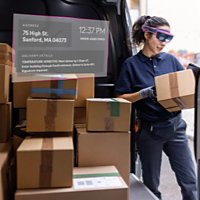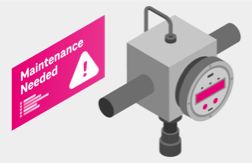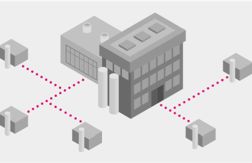The benefits of implementing 5G at scale.


Some new technologies are evolutionary, others are revolutionary. 5G, the fifth-generation cellular standard, is both. Businesses can benefit immediately from 5G’s new and improved wireless capabilities, while also planning to drive innovation in the future with breakthrough new services.
8 minute read
KEY TAKEAWAYS
● 5G offers not just faster connectivity but higher capacity and lower latency communications, crucial advances that support automation, distributed workforces, and more.
● Deployment options for 5G include public and private networks, or a hybrid of both, depending on what best meets your needs.
● 5G’s flexibility allows you to start small, test use cases, then scale to broader applications that can improve operational efficiency, reduce costs, and accelerate time to market.
Given 5G’s progressive nature, it makes sense to take a “crawl, walk, run” approach to adoption. Businesses can test 5G use cases by starting small (crawl), expand to bigger projects (walk), and ultimately pursue bold, broad strategic initiatives over the longer term (run).
5G implementations can differ by industry—ranging from factory floor automation in manufacturing to inventory tracking in retail. But the business imperatives for choosing 5G are the same across industries: the need for greater speed; much lower latency for improved response times; increased bandwidth to support mission-critical operations; and higher reliability for overall business continuity.
This article, focusing on the early going—the “crawl” phase—is the first in a three-part series to help businesses deploy 5G on a timeline that makes sense for them.



Why is 5G becoming so popular? Compared to earlier cellular technologies such as 4G, 5G offers more bandwidth, faster uploads and downloads, increased reliability, and support for more devices within a given physical area.
The number of 5G users is quickly rising. In its Mobility Report for February 2023, the wireless network hardware provider Ericsson estimated that more than 1 billion 5G subscriptions are now active globally. Ericsson forecasts that 5G subscriptions will reach 5 billion by the end of 2028.
More businesses and consumers are making the transition every day. In our 5G "Adoption & Acceleration" Survey of 200 enterprise IT and network decision-makers whose companies have gotten started with 5G, all respondents had made the move within the last two years. In fact, 83 percent of respondents had done so within the previous 12 months, underscoring the recency and rapidity of 5G adoption.
Public 5G services are now widely available, making 5G an excellent solution for remote locations and mobile applications. Our 5G network now reaches 98 percent of Americans—and that footprint keeps expanding. #5GHQ
Why is 5G becoming so popular? Compared to earlier cellular technologies such as 4G, 5G offers more bandwidth, faster uploads and downloads, increased reliability, and support for more devices within a given physical area.
“We need the highest level of connectivity and the fastest networks,” said one IT professional in a third-party research focus group we commissioned, explaining why their company turned to 5G. “There’s just a lot of users and interfaces to support.”
Public 5G services are now widely available, making 5G an excellent solution for remote locations and mobile applications. Our 5G network now reaches 98 percent of Americans—and that footprint keeps expanding.
A well-conceived 5G implementation plan balances today’s growing demands for advanced wireless capabilities with a long-term vision for new efficiencies and other business opportunities.
The following steps will help get the process started:
These best practices can help organizations begin the “crawl” phase of 5G quickly and successfully. Here’s a hypothetical situation that illustrates how this process would work in practice:



Businesses adopt 5G for a variety of reasons. Some seek to give employees and customers a better mobile experience through 5G’s speed, capacity, and reliability. Others are building out network infrastructure in support of automation and operational efficiency.
Here are some of the ways that organizations across industries might get started with 5G:






Determining where to begin often involves conversations between business managers and the IT and networking teams within an organization—as well as with technology partners providing the products, services, and expertise to help identify opportunities and challenges.
David Chan, Director, Product Management at
In our survey, 82 percent of respondents said they were using 5G for greater reliability. That was followed by the pursuit of faster speeds (71 percent), process automation (67 percent), and data accessibility (66 percent).
Why was greater reliability at the top of the list? Because remote work and emerging applications such as virtual reality and virtual healthcare require unfailing connectivity. One of the IT professionals that participated in our focus group said their organization, with offices across the U.S., was, “searching for something that would have more reliable speed and a more consistent signal.”
82%
of our survey respondents are using 5G for greater reliability.
Business managers view 5G as an enabling technology to help them advance digital transformation projects in areas such as customer experience and employee engagement. “For us, the most important factor was the innovation aspect,” said another focus group participant. “We knew that we had to jump ahead of our competitors and adopt 5G as early as possible.”
Because 5G is the first generation of cellular connectivity designed explicitly with business needs in mind, it’s increasingly being used in conjunction with other emerging technologies. In our survey, 48 percent of respondents said they were using 5G with artificial intelligence, and 26 percent were using 5G with augmented reality.
5G services are available over our far-reaching public 5G network, through tailored private 5G networks, or a combination of both. A hybrid approach can often provide comprehensive services across the widest footprint. Factors that will determine the best solution include the planned use case, a building’s location and design, and existing network infrastructure.
“Whether a business ultimately uses a public, private, or hybrid 5G architecture, our approach [with
Network and IT professionals are often the gatekeepers for network infrastructure and services. But it’s not unusual for line-of-business managers to spur the initial conversation to consider 5G.
Regardless of which team initiates a 5G exploration, it’s essential that business managers and IT teams collaborate on how and where to get started.
For example, here are a few questions that might be asked in a retail environment:
This kind of assessment might help a retail brand determine that the best starting point for a 5G pilot test would be heat-mapping customer traffic through one of its stores. A feasibility program would seek to generate insights into store layout, product displays, and where more retail associates might be needed. Once successful, the initiative can then be expanded.
Businesses in other sectors will have their own industry-specific questions to guide discussions and set priorities.
5G pilot projects might last for three to six months, depending on scope. And even during this crawl phase, businesses can begin plotting the subsequent steps.
That may include assessing the physical readiness of buildings, factories, and campuses for installation of private 5G. For example, the requisite components for a private 5G wireless plan within a building include fiber optic cable, Category 6 wiring, conduit, and an adequate power supply.
And perhaps most crucially: it’s not always necessary for 5G use cases to be perfected before getting started with pilot projects and initial 5G rollouts, according to Jeff Holzinger, Senior Director – Site Development at
Often, the best approach is to “start now, start small, and perfect over time,” Holzinger adds. The potential payoff of getting started right away is the ability to provide a better user experience or customer experience sooner than would have been possible otherwise.
Then, it’s time to begin planning for the walk and run phases of 5G. “There are a lot of applications and use cases going through the incubation period and being developed now,” says Holzinger. “Build for the future.”
For more on how to “crawl, walk, and run” with 5G in business, see:
WALK: Moving from 5G exploration to embracing use cases at scale.
RUN: Accelerating innovation and strategic advantage with 5G.
5G: Capable device required; coverage not available in some areas. Some uses may require a certain plan or feature; see
Ready to start building your 5G future?